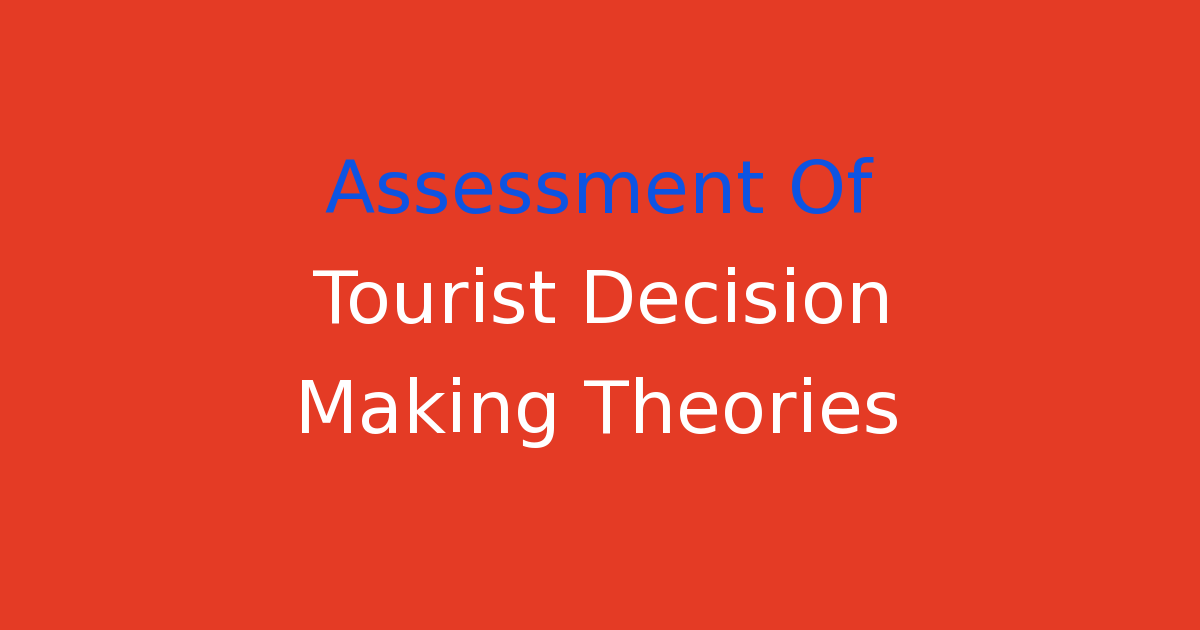Review of theories on tourist decision-making processes.
Assessment of Tourist Decision Making Theories
Introduction
Tourism is a rapidly growing industry that plays a significant role in the global economy. Tourists make decisions on various aspects of their travel such as destinations, transportation, accommodation, activities, and more. Understanding tourist decision-making is important for businesses and destinations to attract and retain visitors. In this project, we will assess the existing theories of tourist decision-making and propose a new system to improve the process.
Problem Statement
Tourist decision-making is a complex process influenced by numerous factors such as personal preferences, socio-cultural backgrounds, past experiences, marketing efforts, and more. Existing theories provide valuable insights into how tourists make decisions, but they may not capture all the nuances of the process. As a result, businesses and destinations may struggle to effectively target and engage with potential visitors.
Existing System
The existing theories of tourist decision-making include the Theory of Planned Behavior, the Push-Pull Theory, and the Travel Career Patterns Theory. The Theory of Planned Behavior suggests that intentions are the best predictors of behavior, and these intentions are shaped by attitudes, subjective norms, and perceived behavioral control. The Push-Pull Theory posits that tourists are motivated to travel by both internal factors (e.g., the desire for relaxation) and external factors (e.g., promotional efforts). The Travel Career Patterns Theory suggests that tourists go through different stages in their travel behavior based on experience and personal development.
While these theories have been valuable in understanding tourist decision-making, they may have limitations. For example, they may not fully account for the role of emotions, the influence of social media, or the impact of unforeseen events such as the COVID-19 pandemic. As a result, businesses and destinations may not have a comprehensive understanding of why tourists make certain choices.
Disadvantages
The disadvantages of the existing system of tourist decision-making theories include the potential for oversimplification, the lack of consideration for emerging trends, and the limited ability to predict changes in behavior. This can lead to a mismatch between the offerings of businesses and destinations and the preferences of tourists, resulting in missed opportunities for engagement and revenue generation.
Proposed System
To address the limitations of the existing system, we propose a new model of tourist decision-making that integrates traditional theories with emerging concepts such as emotional intelligence, social influence, and dynamic decision processes. This new system will take into account the complexities of tourist behavior and provide a more holistic understanding of why tourists make certain choices.
Advantages
The proposed system of tourist decision-making offers several advantages over the existing system. By incorporating a broader range of factors that influence tourist behavior, businesses and destinations can better tailor their offerings to meet the needs and desires of visitors. This can lead to increased customer satisfaction, loyalty, and revenue generation. Additionally, the new system is designed to be flexible and adaptive to changes in the market, ensuring that businesses and destinations can respond effectively to evolving trends and preferences.
Features
The key features of the proposed system of tourist decision-making include a focus on emotional intelligence, social influence, and dynamic decision processes. Emotional intelligence will be used to understand the role of emotions in tourist behavior and how they impact decision-making. Social influence will be considered to account for the impact of peers, influencers, and social media on travel choices. Dynamic decision processes will be integrated to capture the fluid nature of tourist behavior and the need for real-time analysis and adaptation.
Conclusion
In conclusion, the assessment of tourist decision-making theories is essential for businesses and destinations to attract and retain visitors in the competitive tourism industry. By understanding the complexities of tourist behavior and proposing a new system that integrates traditional theories with emerging concepts, we can improve the process of targeting and engaging with tourists. This new system offers advantages such as increased customer satisfaction, loyalty, and revenue generation, as well as the flexibility to adapt to changes in the market.Overall, the proposed system of tourist decision-making represents a significant step forward in enhancing the success of businesses and destinations in the tourism industry.

